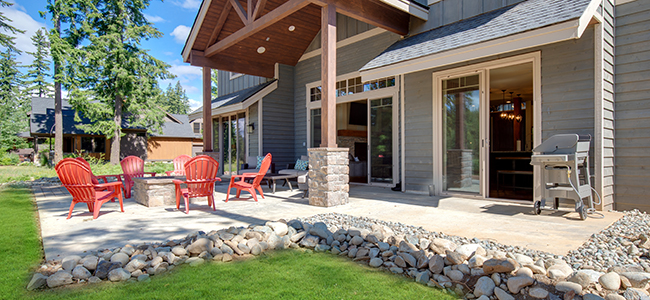
While we often think of wildfires as being a western problem, the threat from wildfires has increased in almost all areas of the U.S. California and the Pacific Northwest get much of the attention, however, wildfires burned hundreds of thousands of acres in the southeast, mid-Atlantic, New England, the Midwest, the Great Plains, and the Rocky Mountain states in 2019. For people living in rural settings, small towns or the farthest reaches of suburbia, wildfires are a real risk. Here are some landscaping tips to help reduce fire risk.
First, trees and shrubs close to the house provide the greatest risk to your home. They can catch fire and easily spread to the walls and roof. Strong winds can also blow sparks onto your roof from tree limbs that are ten to fifteen feet away. Aim for a 30-foot safety zone around your house and any other buildings. Relocate or eliminate existing trees that are less than thirty feet from your house. Keep shrubs small, well pruned, and away from buildings. Prune tree limbs that come within fifteen feet of your roof or walls.
When possible, avoid highly flammable plants, including most pines, evergreens, junipers and fir trees. Two notable exceptions are Ponderosa pines and Western larches as they have thick bark and high water content in their needles. Additionally, deciduous shrubs are more fire-resistant than conifers. Consult with a garden center about good choices for your area. Choose low growing rather than vertical bushes, and prune back any dead branches.
A good rule of thumb is that plants with strongly scented oils are likely to be highly flammable. An exception is lavender, provided it is kept well-watered. Drought-tolerant plants are another good choice, as they will be less likely to turn dry and brown. The more green and lush your annuals and perennials are, the more fire-resistant they will be.
When designing planting beds, keep them five feet from the house. Create gravel or rock borders between the house and planting beds, and keep them clear of dead vegetation. Ground cover vines, like ivy and vinca, are good choices for creating visual interest and differentiating between lawn and beds, but be sure that they don’t start growing up walls or other structures.
Rather than tall ornamental grasses, which dry and can be fuel for a wildfire, consider planting sedges. They grow in short, tidy clumps, rather than spreading like grasses do, and they can be evergreen. Succulents, like sedum, hens and chickens, and yuccas, are also good choices, as they store water and will be less likely to dry out.
Bark mulch can be a fire hazard if it dries out, so consider choosing gravel or rock instead. If you do opt for bark mulch or wood chips, be sure to water frequently enough to keep it damp. Rock gardens with a variety of succulents and perennials are a good choice when landscaping to reduce fire risk.
When designing outdoor living spaces, avoid wooden decks, especially if they’re built adjacent to the house. Choose brick or paver patios instead, with low (2-3 foot) walls that can act as a fire break. And rather than using stepping stones to connect areas, create gravel or paver pathways. If wide enough, they can help stop fires from spreading to your house.
With thought and care, you can design a beautiful landscape that helps reduce fire risk. But the most important step will be to maintain it. Keep grass mowed, debris cleared away, and trees and shrubs pruned.






